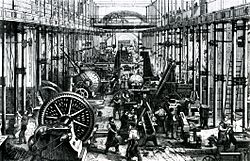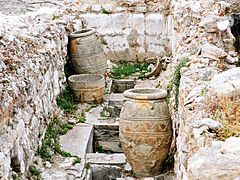Economy facts for kids

An economy is a system for allocating resources to meet people's needs and wants. It determines how goods and services are made and exchanged.
Two important terms in an economy are goods and services. Goods are physical objects that are bought and sold. They include things like cars, food, and clothes. Services are actions that one person pays another to do for them. Services include things like medical care, teaching, fire-fighting, and baby-sitting.
Economics is often divided up into macroeconomics and microeconomics.
Examples of microeconomics include:
- Why someone chooses to buy one product over another
- How the supply and demand of products work together
- What price a company charges for its product
- Why different jobs make different amounts of money
Examples of macroeconomics include:
- The Gross National Product of a country
- Unemployment rates
- Net imports and exports for a country and how this affects jobs
- The current rate of inflation
Contents
Types of Economies
- Traditional - A traditional economy is typically based on bartering, trading, and farming. The economy is largely determined by how things have been done in the past with little change. People in traditional economies tend to do the same jobs as their parents.
- Market - A market economy (sometimes called a "free market") is one based on supply and demand. Consumers are free to buy whatever product they want. Companies can make whatever product they want. There is little government intervention allowing the economy to sort itself out through competition.
- Command or Planned - A command economy is one where the government closely controls the economy. The government determines what goods are manufactured, the price they will be sold, and who gets the profits. The government owns many of the major industries.
- Mixed - A mixed economy is a combination of a market and a command economy. Some industries are owned and controlled by the government, while other industries are allowed to be determined by the market. Mixed economies vary in how much control and regulations the government has.
Economic phases
The economy may be considered as having developed through the following Phases:
- The ancient economy was mainly based on subsistence farming.
- The industrial revolution phase lessened the role of subsistence farming, converting it to more extensive and mono-cultural forms of agriculture in the last three centuries. The economic growth took place mostly in mining, construction and manufacturing industries. Commerce became more significant due to the need for improved exchange and distribution of produce throughout the community.
- In the economies of modern consumer societies phase there is a growing part played by services, finance, and technology—the knowledge economy.
In modern economies, these phase precedences are somewhat differently expressed by the three-sector theory.
- Primary stage/degree of the economy: Involves the extraction and production of raw materials, such as corn, coal, wood and iron. (A coal miner and a fisherman would be workers in the primary degree.)
- Secondary stage/degree of the economy: Involves the transformation of raw or intermediate materials into goods e.g. manufacturing steel into cars, or textiles into clothing. (A builder and a dressmaker would be workers in the secondary degree.) At this stage the associated industrial economy is also sub-divided into several economic sectors (also called industries). Their separate evolution during the Industrial Revolution phase is dealt with elsewhere.
- Tertiary stage/degree of the economy: Involves the provision of services to consumers and businesses, such as baby-sitting, cinema and banking. (A shopkeeper and an accountant would be workers in the tertiary degree.)
- Quaternary stage/degree of the economy: Involves the research and development needed to produce products from natural resources and their subsequent by-products. (A logging company might research ways to use partially burnt wood to be processed so that the undamaged portions of it can be made into pulp for paper.) Note that education is sometimes included in this sector.
Other sectors of the developed community include :
- the Public Sector or state sector (which usually includes: parliament, law-courts and government centers, various emergency services, public health, shelters for impoverished and threatened people, transport facilities, air/sea ports, post-natal care, hospitals, schools, libraries, museums, preserved historical buildings, parks/gardens, nature-reserves, some universities, national sports grounds/stadiums, national arts/concert-halls or theaters and centers for various religions).
- the Private Sector or privately run businesses.
- the Social sector or Voluntary sector.
Economic measures
There are a number of ways to measure economic activity of a nation. These methods of measuring economic activity include:
- Consumer spending
- Exchange rate
- Gross domestic product
- GDP per capita
- GNP
- Stock Market
- Interest rate
- Government debt
- Rate of Inflation
- Unemployment
- Balance of Trade
Related pages
Images for kids
-
Frankfurt Stock Exchange in 2015
See also
 In Spanish: Economía para niños
In Spanish: Economía para niños






